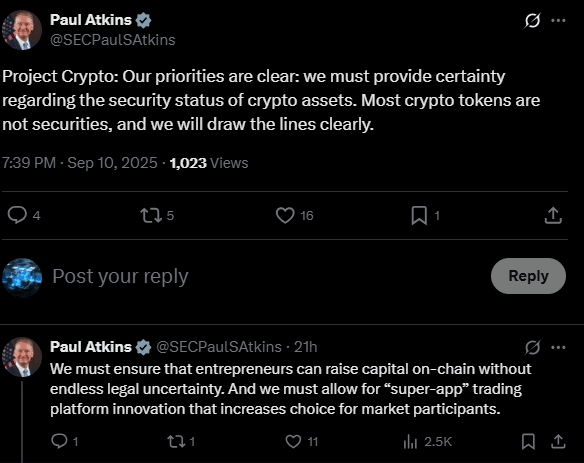The SEC chair proposed a single, streamlined regulatory framework for “super-app” crypto platforms to reduce duplicative rules and enable on‑chain capital formation. This approach aims to treat multi-service apps under one regime, increasing market choice while protecting investors.
-
Single framework for multi-service crypto apps
-
Proposal focuses on minimizing duplicative rules to lower compliance costs for innovators.
-
Regulators cite Project Crypto and CFTC coordination; congressional action may follow.
Meta description: SEC super-apps: SEC chair proposes a single regulatory framework for multi-service crypto platforms to boost innovation and clarity — read the key takeaways.
What did the SEC chair say about super-apps and crypto tokens?
SEC super-apps should be governed by a lean, single regulatory framework that treats integrated trading, custody, lending, payments and staking services consistently. Paul Atkins said most crypto tokens are not securities and recommended allowing on‑chain capital formation with clear, proportionate rules.
How would a single regulatory framework for super-apps work?
The chair proposes a unified approach that maps activities—trading, custody, lending, staking, and payments—to appropriate rules rather than licensing each activity separately. This reduces duplication, lowers barriers for startups, and aims to preserve investor protections while enabling innovation.
Why is the SEC pushing for regulatory clarity now?
The push aligns with the agency’s Project Crypto agenda and joint efforts such as the CFTC’s Crypto Sprint to bring markets on‑chain under clear rules. The timing coincides with congressional deliberations on a crypto market structure bill, which could codify parts of the framework.
At an address at the Organisation for Economic Cooperation and Development (OECD) in France on 10 September, Paul Atkins said:
“And we must allow for ‘super-app’ trading platform innovation that increases choice for market participants.”


Source: X
What are the practical steps regulators propose?
-
Map activities to tailored rules: Define trading, custody, lending, staking and payments under criteria that avoid duplicate oversight.
-
Proportionate compliance: Apply the “minimum effective dose” of regulation to protect investors without stifling startups.
-
Coordinated federal approach: Align SEC, CFTC and legislative action to provide predictable on‑chain market structure.
A push towards regulatory clarity
Atkins emphasized that regulators should avoid overburdening entrepreneurs with duplicative rules that only the largest incumbents can bear. A single framework aims to streamline approvals and lower compliance costs for multi‑service platforms.
Currently, the U.S. regulatory approach treats each crypto activity—brokerage, custody, payments, lending, staking—separately. Under the proposed model, multi‑service platforms would be evaluated holistically to determine the appropriate rule set for each activity, reducing uncertainty for developers and investors.
This initiative sits within the broader Project Crypto agenda to move financial market infrastructure on‑chain while preserving investor safeguards. Coordination with the CFTC’s Crypto Sprint and legislative discussions in Congress are expected to shape final outcomes in the coming months.
SEC Commissioner Caroline A. Crenshaw urged a cautious pace in June: “With issues this complex and stakes this high, it’s better to do it right than fast. We need to grapple with the tough questions through the legally sanctioned process of formal rulemaking.”
Frequently Asked Questions
Are most crypto tokens securities?
Paul Atkins stated that most crypto tokens are not securities. Determinations depend on specific token attributes and functionality rather than categorical treatment.
How will super-apps affect investor protections?
Regulators aim to keep core investor protections—disclosure, custody standards, market integrity—while simplifying overlapping requirements for platforms offering multiple services.
Key Takeaways
- Unified regulation: A single framework could simplify compliance for multi-service crypto apps.
- Proportionate approach: Regulators want the minimum effective regulation to protect investors and foster competition.
- Coordination and legislation: Final rules will likely result from SEC/CFTC coordination and congressional action.
Conclusion
The SEC chair’s call for a lean, single regulatory framework for super-apps signals a shift toward pragmatic, activity‑based oversight that supports on‑chain capital formation. Stakeholders should monitor Project Crypto updates and congressional developments for next steps. Article by COINOTAG; last updated 2025-09-11.